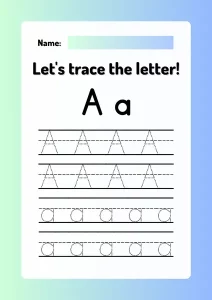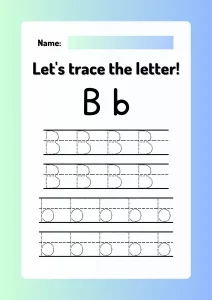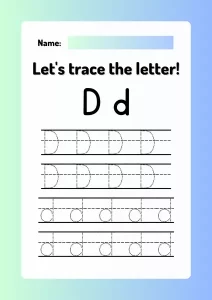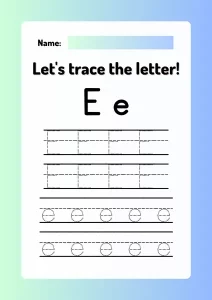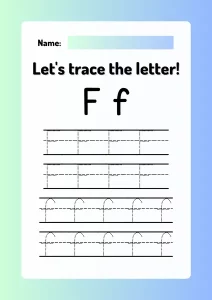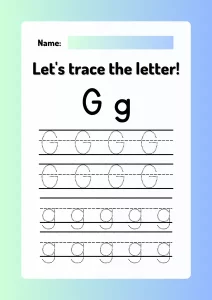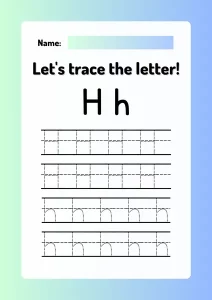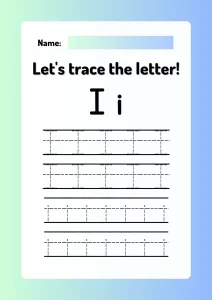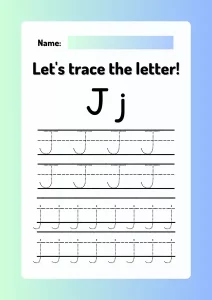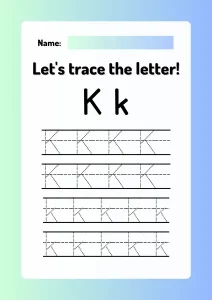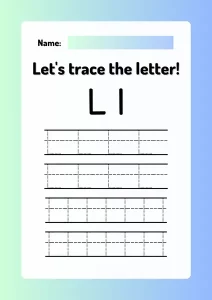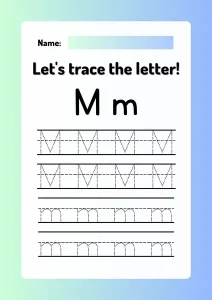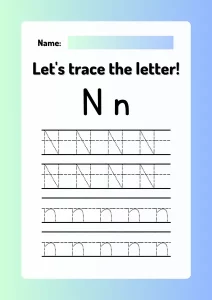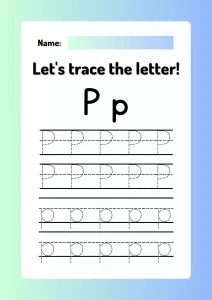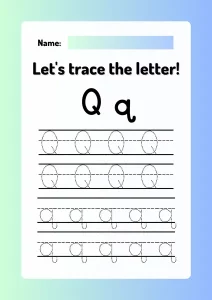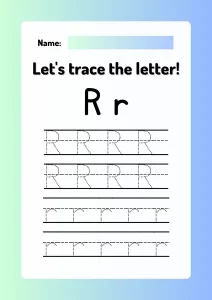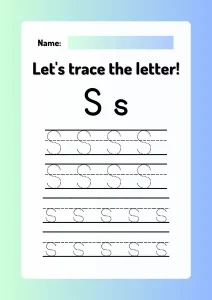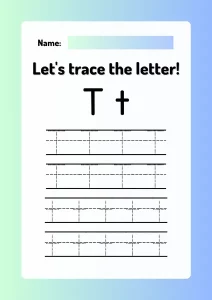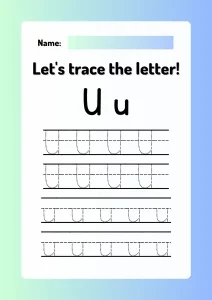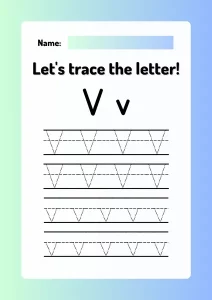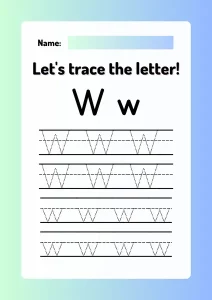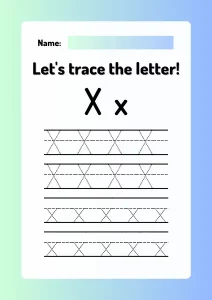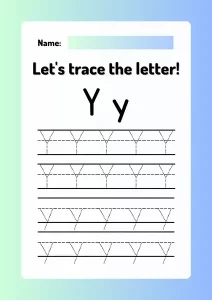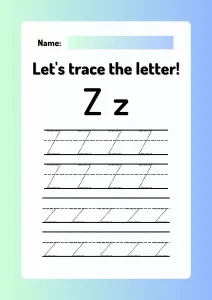Letter tracing worksheets a-z: Learning to write is one of the most significant accomplishments of a child. They said it is as if they pop a lock within them that enables them to give out whatever they are thinking, whichever storey they are having or whichever idea they have in their mind. But before kids can master writing essays or penning heartfelt letters, they need to start with the basics: forming letters correctly. This is where letter tracing comes in handy in early learning progression as a significant invention.
In this article, you will understand why letter tracing is so beneficial. Discover some fun tips for getting started for parents and teachers alike and free printable letter tracing worksheets.
Why Letter Tracing so Important
While letter tracing can be viewed as a dull pencil and paper activity, it benefits little learners. It’s like giving cardiovascular training for their brains and little hands in preparation for the demanding chore of writing. Here are some key reasons why letter tracing is so vital:
Develops Fine Motor Skills:
Imagine how many muscles are within one’s arm to grip a pencil or make detailed strokes. Children develop muscles in their fingers, hands, and wrists through meaningful letter tracing.
Improves Hand-Eye Coordination:
They also build hand-eye coordination, vital for many events, such as games, music, and even driving, when they are older.
Reinforces Letter Recognition:
When children trace each letter, they understand the shape, name and voice of the letter in question. This repetition assists the child in practising the alphabet and developing a good foundation for reading and writing skills. They start comprehending that in each letter lies a particular sound, an idea referred to as the alphabetic principle.
Builds Muscle Memory:
By tracing the same letter repeatedly, children engrain the best handwriting habits into their muscle memory. Through practice, their fingers begin to know how to draw each letter, and the movements required for this become second nature. This is quite similar to learning to ride a bicycle – at some point, we will fall off several times before we master the skill.
Boosts Confidence:
Children like to succeed when tracing letters, even when they need assistance. This way, they see their progress and feel proud of their growing abilities as they work through the exercises. This boost in confidence may convince them to engage in higher-order literacy activities.
Prepares for Independent Writing:
Tracing letters links letter identification and the ability to write letters themselves. It affords a procedural format that gradually recedes as the children themselves come into dominant influence over their composing.
Tips for Parents and Teachers: How best to teach Letter Tracing and keep students engaged
Letter tracing is helpful; however, children may find it monotonous or uninteresting. Here’s how parents and teachers can make it more engaging and effective:
1. Start with the Right Tools:
- Use Thick Pencils or Crayons: These are relatively easier to control, given the learners’ small hands, especially in the primary classes. Consult and concentrate on triangular-shaped pencils or pencil grips, which help support developing the correct grasping capacity.
- Try Different Writing Surfaces: Please do not just make tracing on paper. Encourage children to practise writing letters on sand, foam, shaving cream, or, if you dare – on a bathroom mirror that has softened after a hot shower. This brings another aspect of learning that simply makes the activity more enjoyable and easier to remember.
If you have Paintbrushes, then you can paint on them. If you have Markers, then you can write on them. If you have Chalk, then you can use them.
2. Make it a Game:
- Connect the Dots: Instead of connecting all the dots to draw a single line, try using dots as your letters. It allows children to join many dots to form the letter, making it good problem-solving.
- Race to the Finish: A child can be timed while trying to trace the given letters to see how many they get right. It can be used as a more entertaining manner to push a student to type faster while keeping an eye on the letters being typed. But again, only do this where the letters involved are those your child knows quite well already.
- Letter Scavenger Hunt: Conceal various letters from coloured paper and instruct children to look for them in the classroom. After finding a letter, the child can put it on the worksheet properly.
3. Focus on One Letter at a Time:
- Introduce Letters Gradually: This is a good technique that should not be packaged by attempting to teach children all the alphabet letters in one sitting. Initiate issues with a portfolio of fundamental letters whereby the learning progression from basic letters such as the t and hose of their name escalates, and the process to more advanced types as the child gains mastery of the game.
- Group Similar Letters: Some letters are shaped like others; for example, c looks like o, while b, d, p, & q are somewhat similar. These should be taught together to enable children to learn the differences and avoid those easily reversible errors.
4. Incorporate Multi-Sensory Activities:
- Say the Letter Sound: Point at the letter and ask children to say the sound the letters makes as they trace it. This adds to the relation between the shape of the letter and the sound being produced.
- Use Playdough or Clay: Have children use playdough or clay to make letters; roll it with your hands into long ropes and then flatten it to form the letters. Learning about adequately handling utensils and helping children recognise letters is also a good activity.
- Sing Alphabet Songs: There are innumerable songs based on Alphabet, which may help children to learn different letter names and sounds. Then, sing along while tracing the letters on the children’s toys.
- Air Writing: Let children use their fingers to practise the letters in the air. This a nice session to practise letter formation without drawing utensils or any writing material.
5. Offer Positive Reinforcement:
- Praise Effort and Progress: Try to compliment the child more for trying hard and being hard-working rather than for doing their work perfectly. Use phrases like, “I know that you are doing your best when drawing within the lines” or “You are improving so much in writing the letter B”.
- Display Their Work: The completed worksheets should be hung on the refrigerator or anywhere else, and children feel proud that you like their work.
- Use Stickers or Stamps: Children can be easily encouraged; even a small sticker on the calendar or a rubber stamp serves the purpose of early childhood.
6. Keep it Short and Sweet:
- Limit Tracing Sessions: Children of a young age are always jumpy; hence, when you are tracing, it’s good to do it in small intervals, at about 5-10 minutes.
- Take Breaks: It is essential not to allow a child to work for a long time without being able to cope. Instead, one should step aside and then come back after some time. Continuing to compel them will only make the act associate a positive aspect of learning with a worthless chore for which they aren’t being compensated.
7. Make it Relevant:
- Trace Words They Care About: Begin with the tracing of their name, name of relatives, or favourite items. It also makes the activity more enjoyable and makes people feel very personal.
- Create Personalized Worksheets: Add images of objects that are fascinating for the child, for example, animals, cars, or favourite cartoon characters, to the letters.
8. Be Patient and Supportive:
- Every Child Learns at Their Own Pace: It was observed that while several children are quick to grasp the formation of letters, others are slow learners. Patients and do not mind them with other children of the same age or even younger who may be more advanced.
- Offer Guidance, Not Criticism: If a child is tricky, help them to be gentle by correcting their hand movement or reacting through words. Scoring them for their mistakes is unwise since it will deter them from their practice.
Free Printable Letter Tracing Worksheets A-Z
To help you get started, here are some free printable letter tracing worksheets a-z with fun themes:
Conclusion:
Free printable letter tracing worksheets a-z is the groundwork for a lifetime of reading.
Following these tips and utilising such free printable worksheets, parents and teachers can assist young kids in developing correct handwriting, fine motor skills and coordination, colouring, and letter recognition necessary to make children efficient and self-confident writers.
Thus, ensure it is fun, positive and targeted at each child. With a lot of encouragement, appropriate rewards, and encouragement, you can demonstrate to them that writing is one of the most potent tools and set them on the path of learning and discovery!
